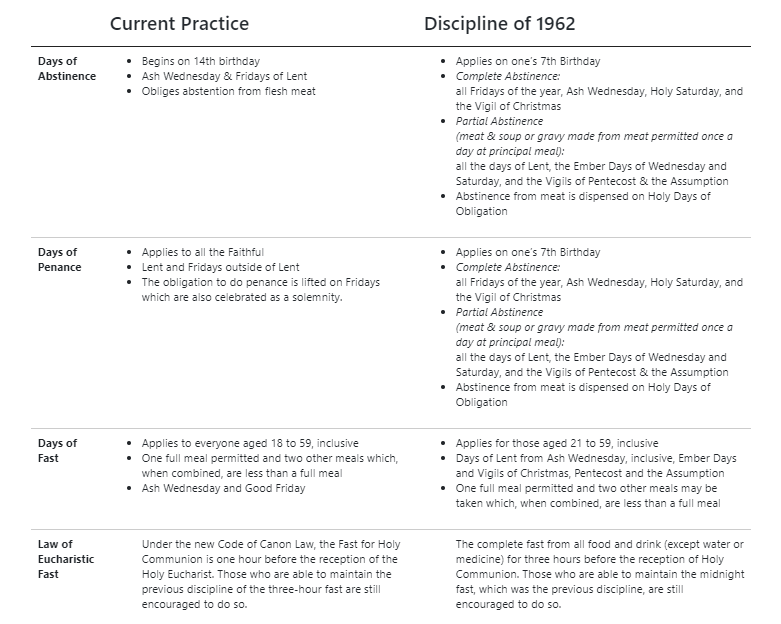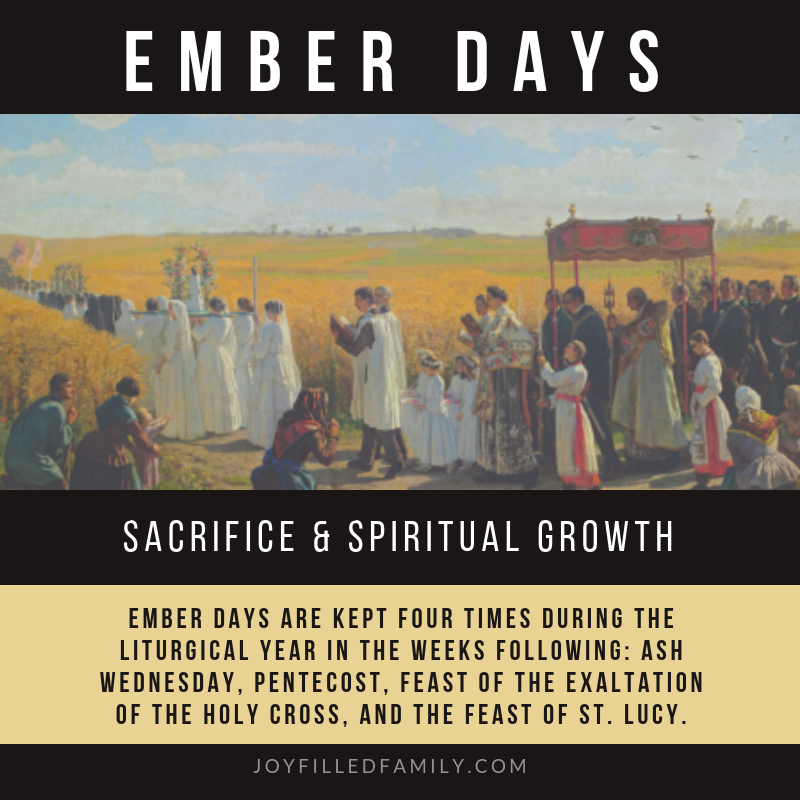The purpose of their introduction, besides the general one intended by all prayer and fasting, was to thank God for the gifts of nature, to teach men to make use of them in moderation, and to assist the needy.
The week following the Exaltation of the Holy Cross (September 14), features the so-called “Ember Days” of September (the English word “ember” being a permutation of the Latin title Quattuor Temporum Septembris).
Here’s a catchy rhyme that has been used in English for a couple hundred years to help the faithful remember when four Ember Days occur.
Lenty, Penty, Crucy, Lucy.”
Meaning, the weeks following: Ash Wednesday, Pentecost, Feast of the Exaltation of the Holy Cross, Feast of St. Lucy.
This special week of September on the liturgical calendar is one of the four seasonal weeks (thus, Quattuor Temporali, or Four Seasons) that have Ember Days which are related to the harvest of the fruits of the earth, which through fasting and penance we pray will be bountiful. This is also why it was customary for ordinations to holy orders (particularly the priesthood) to be held on these days, for the clergy are the harvesters of souls in the Lord’s vineyard.
Jesus Himself has willed to conform by a comparison our faith in His sanctifying influence: “I am the vine,” He said, “you are the branches” (Jn 15:5). The branches have life, but they do not themselves provide the sap which nourishes them. They are constantly drawing their vitality from the sap which comes from the parent stem. Coming itself from another source, it is this sap which gives them life.
And so it is for the members of Christ: their good actions, their practice of the virtues, their spiritual progress, their sanctity, belong to them certainly; but it is the sap of grace coming from Christ which produces these wonders in them: “As the branch cannot bear fruit of itself, unless it abide in the vine, so neither can you unless you abide in Me” (Jn 15:4). Christ the Ideal of the Priest
~Dom Columba Marmion (Benedictine abbot at Maresous; 1858-1923)
Fasting & Abstinence
Current Practice vs. 1962 Discipline

As a help in understanding the Church’s discipline of fast and abstinence, the following summary of the requirements, both current and those in force in 1962, has been excerpted from the Liturgical Ordo published by the Priestly Fraternity of St. Peter.
History of the Ember Days
The Ember Days, which were historically kept four times during the liturgical year, have a venerable history. Here is the explanation from the 1917 Catholic Encyclopedia.
The purpose of their introduction, besides the general one intended by all prayer and fasting, was to thank God for the gifts of nature, to teach men to make use of them in moderation, and to assist the needy. The immediate occasion was the practice of the heathens of Rome. The Romans were originally given to agriculture, and their native gods belonged to the same class. At the beginning of the time for seeding and harvesting religious ceremonies were performed to implore the help of their deities: in June for a bountiful harvest, in September for a rich vintage, and in December for the seeding; hence their feriae sementivae, feriae messis, and feri vindimiales. The Church, when converting heathen nations, has always tried to sanctify any practices which could be utilized for a good purpose. At first the Church in Rome had fasts in June, September, and December; the exact days were not fixed but were announced by the priests. The “Liber Pontificalis” ascribes to Pope Callistus (217-222) a law ordering the fast, but probably it is older. Leo the Great (440-461) considers it an Apostolic institution. When the fourth season was added cannot be ascertained, but Gelasius (492-496) speaks of all four. This pope also permitted the conferring of priesthood and deaconship on the Saturdays of ember week–these were formerly given only at Easter. Before Gelasius the ember days were known only in Rome, but after his time their observance spread. They were brought into England by St. Augustine; into Gaul and Germany by the Carlovingians. Spain adopted them with the Roman Liturgy in the eleventh century. They were introduced by St. Charles Borromeo into Milan. The Eastern Church does not know them. The present Roman Missal, in the formulary for the Ember days, retains in part the old practice of lessons from Scripture in addition to the ordinary two: for theWednesdays three, for the Saturdays six, and seven for the Saturday in December. Some of these lessons contain promises of a bountiful harvest for those that serve God.
Keeping with Tradition
Catholics who have access to the traditional liturgy outside of Sundays are encouraged to make a special point to assist at Mass on Wednesday, Friday, and Saturday of this week. In addition to keeping the fasting and abstinence prescriptions on these days, the faithful should be attentive to the special collects and readings that are assigned on these days.

Here, for instance, are the Collects from Wednesday, which properly capture the spirit of these days.
May our frailty, we beseech Thee, O Lord, find support in the help of Thy mercy; so that what is marred by its own nature may be restored by Thy grace.
O Lord, we beseech Thee, grant to Thy praying household that, as they fast from bodily food, they may also abstain mentally from sin.
—-
“Unless you do penance, you shall likewise perish.” (Lk. 13:5)

Resources:
- Printable illustrated guide explaining both the Rogations and Ember Days
- September Ember Days – Fr. Ripperger, FSSP
- Ember & Rogation Days Sermon Audio – Fr Ripperger
- Rogation Days – JOYfilledfamily
-
Ember Days – Fish Eaters
- Ember Days – Catholic Encyclopedia
- The Ember-Days of September – Dom Gueranger
- The Golden Legend: The Ember Days – Fordam University
- Reparation: Bishop Morlino Calls fo Ember Days Prayer & Fasting
- Ember Wednesday Propers
- Ember Friday Propers
- Ember Saturday Propers
- On the Laws of Fasting – FSSP
- Fasting & Abstinence Simplified

Wonderful. This is new to me. Can’t wait to celebrate.